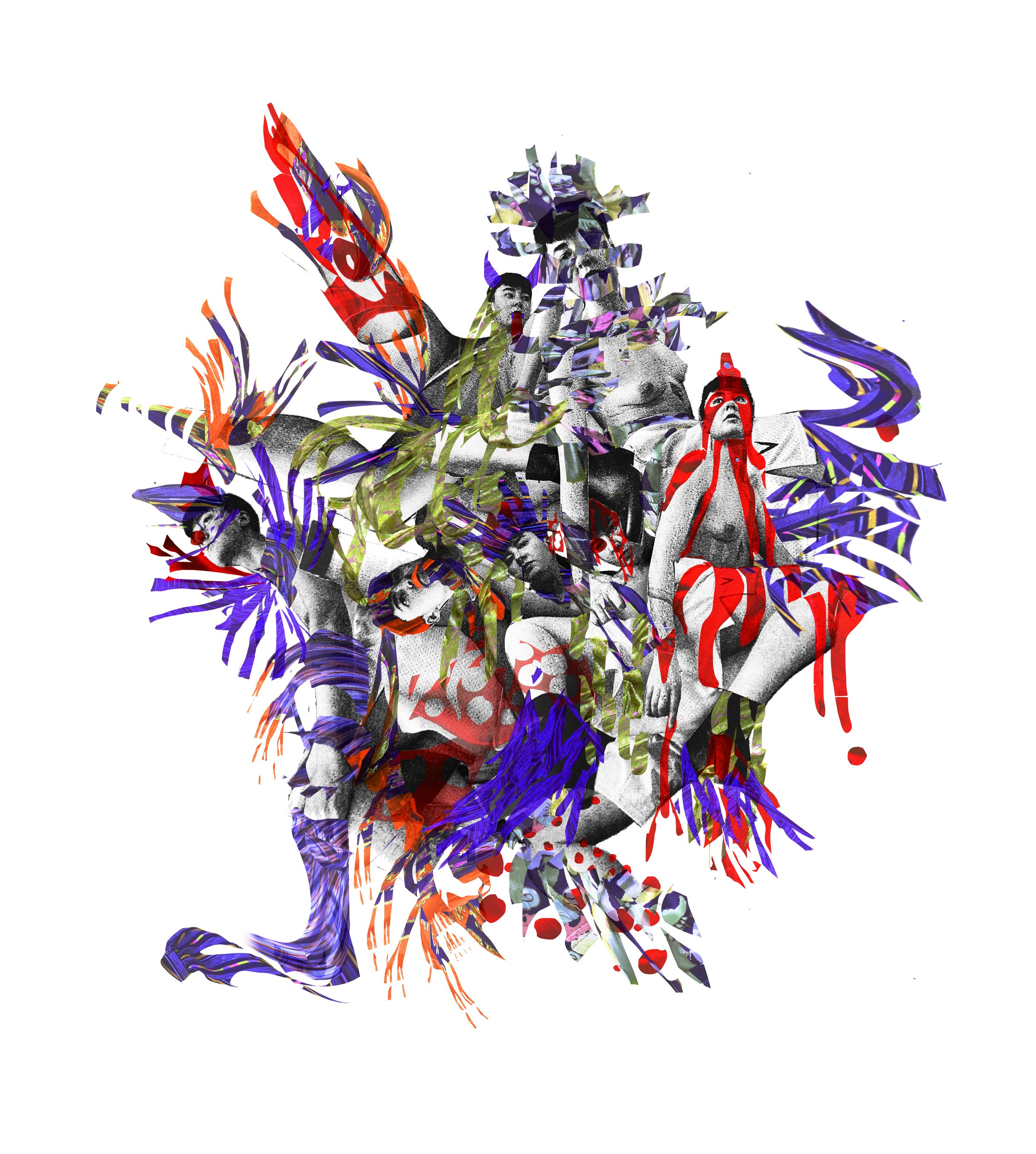Flagging Chimera
lou croff blake
This self-portrait collage is an exercise in creative destruction, a therapeutic slicing and dicing of beloved items from my wardrobe, hacking my routine outfits into fanatical chaos. The resulting assemblage elicits gender euphoria for my chimeral avatar.
Xeroxed selfies with digital wardrobe collage. Six grainy, black and white cut-outs of a white, trans masculine person with no shirt, white basketball shorts, and black heeled boots are intertwined in a mass, merging into a single body. Brightly colored slices of fabric are collaged on top, creating a playful, skimpy, uncohesive outfit. Breasts are often exposed and details include horns, streamers, and a clown nose.
Not they/them as in Third Androgynous Gender Option, they/them as in a body that is crowded with Us. A chorus of both resonant and dissonant selves, contradicting selves, selves who are best friends, selves at war. It’s super loud in here. Queerness, in this body, doesn’t work as a noun; we only know the verb state, the constant motion of teeming I’s, like a beehive, a square dance, or a mosh pit, depending on the day. The more we talk to other queers, the more we realize our churning sense of self is not an anomaly. And as a trans non-binary, testosterizing, gender-bewildered fashion practitioner and scholar, we wonder: how do we dress for this dynamism and multiplicity?
Personally, we’ve found most of our style icons in mythical creatures. For example, goblins are a major inspiration for how we gender-identify on a day-to-day basis: natural born anarchists with an obsession for things that sparkle. We fondly refer to this embodied state as ‘goblin faggotry,’ and it makes us crave garish silk shirts paired with cargo shorts (the pockets are key to goblinized gender euphoria). The goblin faggot is a stance from which we have learned to comfortably navigate the world. It’s gender home-base.
But lately, we’ve cultivated a new-found reverence for the Chimera. Her body has three heads: a lion, a goat, and a snake. She didn’t get a great lot in mythology – while minding her own business out in the wilderness, some cis-guy (Bellerophon) showed up on Pegasus and slayed her. She wasn’t afforded a shred of character depth by the Greek poets. How misunderstood she’s been, labeled ‘monster’ and killed for it, and how relatable she is to all of us who fear this verdict. Out here in the wilderness that lies beyond the M-F gender spectrum, we’re all chimerical kin. How seen we feel by an old dead creature whose body was home to plural entities.
Brief shout-out to the other Chimerical cousins we love: Jackalopes, Griphens, Hippogryphs, Hydras; we recently learned about Elwetritchen (a south German hybrid between a waterfowl and an elf or troll, who are very shy and live off a diet of Riesling grapes). To embody multiplicity is hardly a new phenomenon, but it hasn’t lost its power. We still become mythic in doing so. Our legacy of plurality lore deserves a wardrobe analysis; We wonder, have we chimeras ever not worn it on our sleeve?
In my current studies of the history of queer semiotic dress, I am accruing a lexicon of symbols and styles that LGBTQIA+ communities have been using for over a hundred years to non-verbally communicate affinity and desire. Garments carry visual cues for everyone, not just queers. What we wear denotes our gender presentation, class, heritage, age, subculture – so many aspects of ourselves, consciously and subconsciously layered onto the body. In a buttoned-up phrase:
“Fashion refers to the symbolic, aesthetic, and cultural meanings that objects carry, especially the ways in which people use objects to express their taste, lifestyle, social status and belonging to a community.”
In the language of fashion, our queer dialects both keep us safe and tell our stories. We use the words ‘flagging’ and ‘signaling’ for this specific method of getting dressed. Historic queer semiotics include the hanky code, the single earring, the monocle, and countless others, alongside a spectacular range of styles and mannerisms. While this ever-evolving dress code bonds us to our revered queer forebears and elders, we can’t help but wonder if it maps onto our community’s present needs. The image of someone flagging ‘dyke’ with a keyring on a belt loop still makes us blush like a schoolgirl, but we (in this one body) do not fit into such a clearly nameable subculture – in gender or in desire. We would be terrible at using the hanky code; we would probably cram a fistful of kerchiefs into both rear pockets, a protruding rainbow laundry basket on each butt cheek, confusing queer suitors and straight passersby alike. Our hesitations around traditional queer semiotics are rooted in our community’s tendency to categorize and subcategorize, to know where we fit in, to find our camp. For those of us who wander between, who shun labels and grow many heads and extra limbs, who enter the chrysalis of gender transition without knowing what form our souped bones will settle into, we need an evolved semiotic closet.
What would it look like to flag chimera? As someone(s) in a queer community that both makes and wears clothes, we upcycle the semiotic canon. We braid a new dress code from its ropey roots of past wardrobes. Chimerizing our style is an art of patchworking a material and symbolic archive, and the flamboyant goblin in us gleefully leads the treasure hunt for esoteric fashion moments from past queer paradigms. In a quest through time and space, we forage for cultural scripts as rare and precious as jewels, obscured by our erasure from the straight history books. We piece together our fractured legacy. We’re hungry for the stories of our elders that are nearly forgotten, but which live on when we find them in memoirs, old boxes of photographs, estate sales. Our jumbled historic aesthetic palette becomes a collage box we pull from when getting dressed, material for the daily remix. Sometimes, this manifests as styling masc and femme garments together in humming dissonance. We often incorporate scripts from our personal history: our beloved blue cowboy boots, acquired at age 16, styled with our newest developments in taste (a reminder that time is both plural and non-linear). This is how we fashion a body with many heads: collect, hack, collage, adorn. The final phase, the big brave leap, is to exit the closet and walk down the street.
The semiotics of chimerical queerness are subtle; it is a language of juxtaposition, mismatching, and mystified sex appeal. A shape-shifter dress code. A time-traveler dress code. An anarchic dress code. Can we recognize each other through the chimerized wardrobe? Are you a chimera too? As with the hanky code, the single earring, or any other established queer semiotic, we’re beginning to recognize the pattern, to see our kin through clues: we’re the ones who dress the motley crew.
_____
Pan, Y., Roedl, D., Blevis, E., & Thomas, J. 2015 Apr 30. Fashion Thinking: Fashion Practices and Sustainable Interaction Design. International Journal of Design [Online] 9:1. Available: http://www.ijdesign.org/index.php/IJDesign/article/view/1372/675

